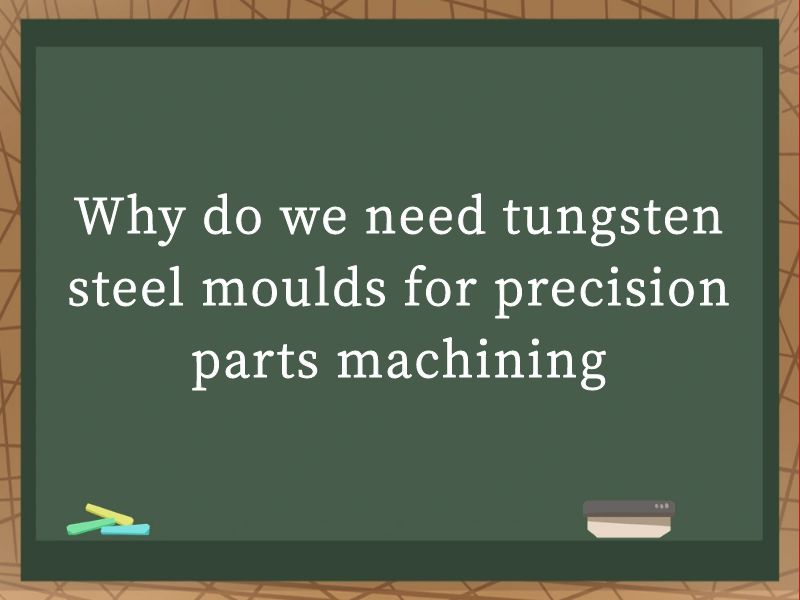JOURNALISM
- NEWS -
|
|
Why do we need tungsten steel moulds for precision parts machiningWhy do we need tungsten steel moulds for precision parts machining.In the realm of precision parts machining, the choice of tooling materials is paramount to achieving the desired accuracy, durability, and efficiency. Among the various materials available, tungsten steel, also known as high-speed steel (HSS) or tungsten carbide-based alloys, stands out due to its exceptional properties that cater to the rigorous demands of precision machining. This article delves into the reasons why tungsten steel moulds are indispensable for precision parts machining, exploring their physical characteristics, performance advantages, and the overall impact on the manufacturing process.
1. Exceptional Hardness and Wear Resistance One of the most notable characteristics of tungsten steel is its exceptional hardness. This hardness, which stems from the high carbon and tungsten content in its composition, makes it highly resistant to wear and tear. During precision machining, tools are subjected to continuous friction and pressure, especially when working with hard materials or under high-speed conditions. Tungsten steel moulds can withstand these forces without significant degradation, ensuring a longer tool life and reduced downtime for tool replacement. The wear resistance of tungsten steel is particularly beneficial in the production of intricate parts where precision is critical. With traditional materials, wear and tear can lead to gradual loss of tool sharpness, resulting in increased tolerances and reduced part quality. Tungsten steel moulds maintain their sharpness longer, allowing for consistent and reliable machining over extended periods. 2. High Thermal Stability Precision machining often involves high temperatures generated by the friction between the tool and the workpiece. Materials with poor thermal stability can lose hardness and strength at elevated temperatures, leading to premature failure. Tungsten steel, however, exhibits exceptional thermal stability, maintaining its mechanical properties even at high temperatures. This characteristic is crucial in applications where the machining process generates significant heat, such as drilling, milling, and turning hard metals. Tungsten steel moulds can withstand the thermal stress without deforming or losing their cutting edge, ensuring that the final parts meet the tight tolerances required for precision machining. Moreover, the high thermal conductivity of tungsten steel helps dissipate heat more effectively, reducing the risk of thermal cracking and extending the tool's lifespan. This makes tungsten steel an ideal choice for continuous and heavy-duty machining operations. 3. Good Toughness and Strength While hardness and wear resistance are essential, the toughness and strength of a tooling material are equally important. Tungsten steel combines high hardness with good toughness, allowing it to resist both abrasive wear and impact damage. This balance of properties is crucial in precision machining, where tools must perform reliably under varying conditions. The toughness of tungsten steel moulds enables them to withstand sudden impacts and vibrations that can occur during the machining process. This resilience helps prevent tool breakage and ensures smoother, more predictable machining operations. Additionally, the strength of tungsten steel allows it to maintain its structural integrity even under high loads, making it suitable for machining tasks that require significant force. 4. Precision and Dimensional Stability Precision parts machining demands tools that can maintain tight tolerances and consistent dimensions throughout the production run. Tungsten steel moulds excel in this regard due to their dimensional stability. The material's low coefficient of thermal expansion means that it changes shape minimally with temperature variations, ensuring that the tool maintains its original dimensions during use. This dimensional stability is critical for achieving precise part dimensions and surface finishes. With tungsten steel moulds, manufacturers can achieve the tight tolerances required for high-precision applications, such as aerospace, medical devices, and automotive components. The ability to maintain consistent dimensions over time also supports repeatability in production, ensuring that each part meets the specified quality standards. 5. Versatility in Machining Applications Tungsten steel's versatility makes it suitable for a wide range of machining applications. Its combination of hardness, wear resistance, and toughness allows it to be used effectively in various machining processes, including milling, drilling, turning, and die casting. This versatility means that manufacturers can rely on a single tooling material for multiple operations, simplifying inventory management and reducing costs. Moreover, tungsten steel moulds can be adapted to machine a variety of materials, from soft metals like aluminum to hard metals like titanium and stainless steel. This adaptability ensures that manufacturers can use tungsten steel for a broad spectrum of precision parts, meeting the diverse needs of different industries. 6. Cost-Effectiveness in Long-Run Production While tungsten steel moulds may have a higher initial cost compared to some other tooling materials, their extended lifespan and reduced downtime make them highly cost-effective in long-run production. The ability to maintain precision and dimensional stability over extended periods means that tungsten steel moulds can produce a higher number of quality parts before needing replacement. This cost-effectiveness is particularly significant in high-volume manufacturing environments where precision and consistency are paramount. By reducing the frequency of tool replacements and minimizing downtime, tungsten steel moulds contribute to increased productivity and lower overall production costs. 7. Environmental Considerations In today's manufacturing landscape, environmental sustainability is an increasingly important consideration. Tungsten steel moulds contribute to more sustainable manufacturing practices by reducing waste and energy consumption. Their long lifespan and ability to maintain precision over time minimize the need for frequent tool replacements, reducing the amount of material waste generated during production. Furthermore, tungsten steel is a recyclable material, which means that worn-out tools can be melted down and reused, further minimizing waste. This recyclability aligns with efforts to promote circular economy principles and reduce the environmental footprint of manufacturing operations. 8. Advancements in Tungsten Steel Technology Continuous advancements in tungsten steel technology are driving further improvements in its performance and applicability in precision parts machining. Modern tungsten steel alloys incorporate additional elements like cobalt and vanadium to enhance their hardness, wear resistance, and toughness. These alloyed compositions offer even better performance in specific machining applications, such as high-temperature environments or machining of difficult-to-cut materials. Moreover, advancements in tool manufacturing processes, such as precision grinding and coating technologies, further enhance the capabilities of tungsten steel moulds. Coatings like titanium nitride (TiN) and titanium aluminum nitride (TiAlN) improve the tool's surface hardness, wear resistance, and lubricity, further extending its lifespan and performance in precision machining tasks. Conclusion In summary, tungsten steel moulds are indispensable for precision parts machining due to their exceptional hardness, wear resistance, thermal stability, toughness, and dimensional stability. These properties enable them to perform reliably under rigorous machining conditions, maintaining tight tolerances and producing high-quality parts. The versatility of tungsten steel in various machining applications, combined with its cost-effectiveness in long-run production and environmental benefits, further solidifies its position as a preferred tooling material for precision parts machining. As technology continues to evolve, advancements in tungsten steel alloys and manufacturing processes will likely unlock even greater performance capabilities, expanding the horizons of precision machining. Manufacturers who invest in tungsten steel moulds will be well-positioned to meet the increasing demands for precision, quality, and sustainability in modern manufacturing environments. |


